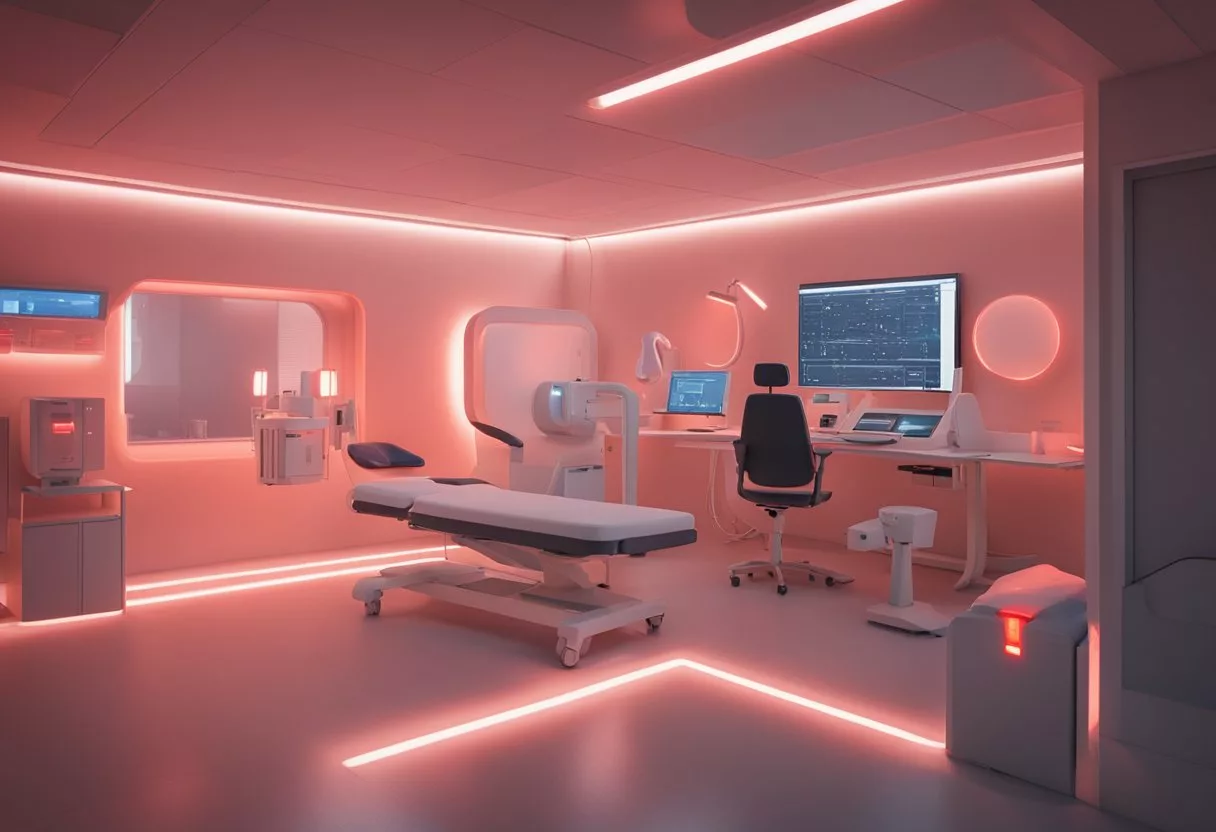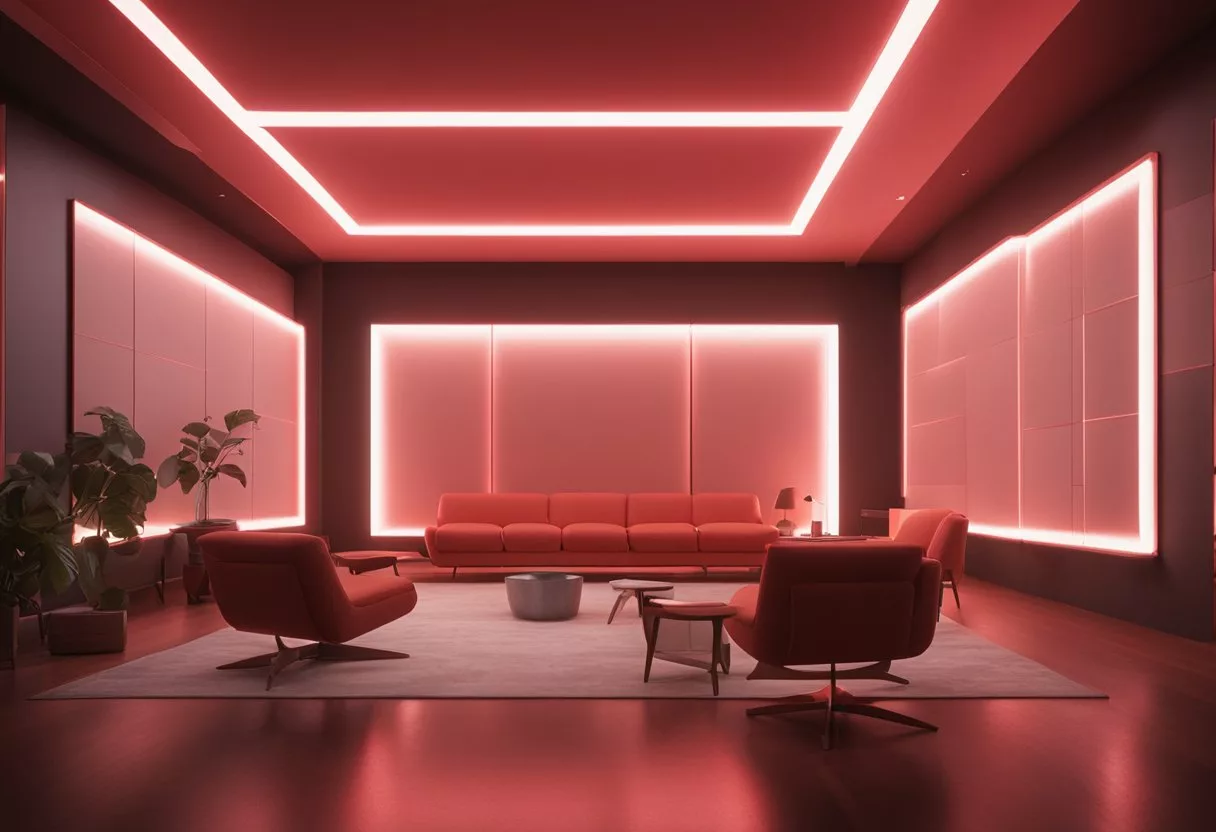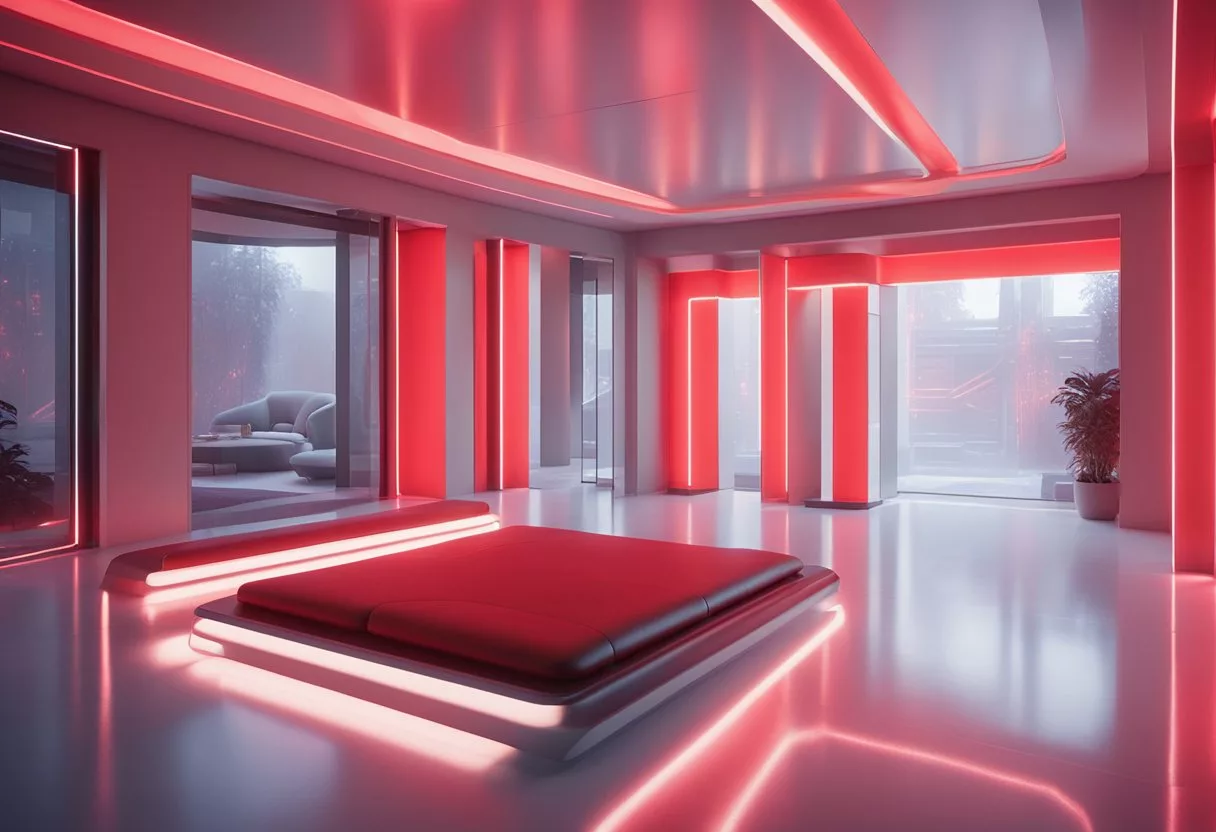Red light therapy is a non-invasive treatment that uses low-level red light to improve skin health, reduce inflammation, and promote healing. The therapy has been gaining popularity in recent years due to its potential benefits and minimal side effects. Red light therapy is also known as photobiomodulation therapy, low-level light therapy, or biostimulation therapy.

Understanding how red light therapy works is key to understanding its potential benefits. Red light penetrates the skin and is absorbed by the cells, promoting the production of ATP, which is the energy currency of the cell. This increased energy production can stimulate the healing of damaged tissues, reduce inflammation, and improve skin health. The therapy has been used to treat a variety of conditions, including acne, wrinkles, pain, and hair loss.
Key Takeaways
- Red light therapy is a non-invasive treatment that uses low-level red light to promote healing and improve skin health.
- The therapy works by increasing energy production in cells, leading to reduced inflammation and improved tissue healing.
- Red light therapy has been used to treat a variety of conditions, including acne, wrinkles, pain, and hair loss.
Understanding Red Light Therapy

Red light therapy (RLT) is a form of photobiomodulation that uses low-level light therapy to stimulate cellular activity in the body. The therapy is based on the scientific principle that specific wavelengths of red and near-infrared light can penetrate the skin and stimulate the mitochondria, the energy-producing powerhouses of cells, to produce more ATP, which is essential for cellular function.
History and Development
RLT has been used in various forms for over 40 years. The therapy was first developed by NASA in the 1980s to help astronauts in space maintain their health and fitness. Since then, RLT has been used to treat a variety of conditions, including skin conditions such as acne and psoriasis, joint pain, and muscle soreness.
Scientific Principles
RLT works by using specific wavelengths of red and near-infrared light to penetrate the skin and stimulate the mitochondria to produce more ATP. The therapy has been shown to increase blood flow, reduce inflammation, and promote tissue repair and regeneration.
Types of Red Light Therapy Devices
There are several types of red light therapy devices available, including handheld devices, light panels, and full-body beds. The devices use different wavelengths of light and have varying power outputs. Some devices also combine red light therapy with other therapies, such as infrared light therapy or low-level laser light therapy.
Overall, red light therapy has shown promise in treating a variety of conditions and promoting overall health and wellness. However, more research is needed to fully understand the benefits and limitations of the therapy.
Benefits of Red Light Therapy

Red light therapy is a non-invasive treatment that uses low-level wavelengths of red light to promote various health benefits. This therapy has been shown to be effective in treating a wide range of conditions, from skin health and anti-aging to pain relief and wound healing. In this section, we will explore some of the key benefits of red light therapy.
Skin Health and Anti-Aging
Red light therapy has been found to be effective in improving skin health and reducing the signs of aging. It stimulates collagen production, which gives skin its structure, strength, and elasticity. Increased fibroblast production also makes collagen, which is a component of connective tissue that builds skin. Red light therapy also increases blood circulation to the tissue and reduces inflammation in cells. These benefits can help reduce the appearance of fine lines and wrinkles, improve skin complexion, and reduce the occurrence of acne.
Pain Relief and Inflammation Reduction
Red light therapy has been shown to be effective in reducing pain and inflammation in various parts of the body. It works by increasing blood flow and oxygen to the affected area, which helps reduce inflammation and promote healing. This therapy has been used to treat conditions such as arthritis, muscle pain, and joint pain, among others.
Wound Healing and Tissue Repair
Red light therapy has been found to be effective in promoting wound healing and tissue repair. It works by stimulating the production of adenosine triphosphate (ATP), which is the energy source for cells. This increase in energy production helps cells repair and regenerate more quickly. Red light therapy has been used to treat various types of wounds, including burns, cuts, and surgical incisions.
Hair Growth and Scalp Health
Red light therapy has also been found to be effective in promoting hair growth and improving scalp health. It works by increasing blood flow and oxygen to the hair follicles, which helps promote hair growth and prevent hair loss. This therapy has been used to treat conditions such as alopecia and improve overall hair health.
In summary, red light therapy has a range of benefits that make it an effective treatment for various conditions. These benefits include improved skin health and anti-aging, pain relief and inflammation reduction, wound healing and tissue repair, and hair growth and scalp health. With its non-invasive nature and proven effectiveness, red light therapy is a promising treatment option for those looking to improve their overall health and well-being.
Clinical Applications and Effectiveness

Red light therapy has been found to be effective in treating a variety of dermatological conditions, musculoskeletal disorders, post-surgical recovery, and mental well-being and sleep.
Dermatological Conditions
Red light therapy has been found to be effective in treating skin conditions such as psoriasis, acne, and wounds. According to a study published in the Journal of the American Academy of Dermatology, red light therapy has been found to be effective in treating psoriasis, with patients experiencing a significant reduction in symptoms after 12 weeks of treatment. Red light therapy has also been found to be effective in treating acne, reducing the number of lesions and improving skin texture and tone. Additionally, red light therapy has been found to be effective in promoting wound healing by increasing blood flow to the affected area and stimulating collagen production.
Musculoskeletal Disorders
Red light therapy has also been found to be effective in treating musculoskeletal disorders such as osteoarthritis and tendinitis. According to a study published in the Journal of Orthopaedic & Sports Physical Therapy, red light therapy has been found to be effective in reducing pain and improving physical function in patients with knee osteoarthritis. Red light therapy has also been found to be effective in reducing pain and improving grip strength in patients with tendinitis.
Post-Surgical Recovery
Red light therapy has been found to be effective in promoting post-surgical recovery by reducing pain and inflammation. According to a study published in the Journal of Athletic Training, red light therapy has been found to be effective in reducing pain and inflammation in patients recovering from knee surgery. Red light therapy has also been found to be effective in reducing pain and improving range of motion in patients recovering from shoulder surgery.
Mental Well-being and Sleep
Red light therapy has shown promise in improving mental well-being and sleep. According to a study published in the Journal of Affective Disorders, red light therapy has been found to be effective in reducing symptoms of depression and anxiety. Red light therapy has also been found to be effective in improving sleep quality and duration in patients with sleep disorders.
Overall, red light therapy has shown promise in treating a variety of conditions and promoting overall well-being. While more studies are needed to fully understand its effectiveness, it is a promising treatment option for those seeking alternative therapies.
Usage Guidelines

Recommended Wavelengths and Frequency
Red light therapy is a non-invasive, low-risk treatment that involves exposing the skin to red light wavelengths. The recommended wavelengths for red light therapy are between 630 to 660 nanometers (nm) and 810 to 850 nm. These wavelengths penetrate the skin and stimulate the production of collagen, elastin, and other proteins that help improve skin health and reduce the appearance of fine lines and wrinkles.
Experts recommend using red light therapy at least 5-6 times per week for best results. For skin health, it is recommended to use red light therapy 5-7 times per week for 10-20 minutes per session. For pain relief, it is recommended to use red light therapy 3-5 times per week for 20-30 minutes per session.
Determining Treatment Duration
The duration of each red light therapy session depends on the distance between the skin and the light source. The closer the light source is to the skin, the shorter the treatment duration should be. Skin requires 3 to 15 joules of red light (660nm) per session. A dosage calculator can be used to determine the appropriate treatment duration based on the distance between the skin and the light source.
Safety Measures and Potential Side Effects
Red light therapy is generally considered safe and has minimal side effects. However, it is important to follow safety measures to minimize the risk of potential side effects. It is recommended to wear protective goggles to prevent eye damage. If using an at-home device, it is important to read the instructions carefully and follow the recommended treatment plan.
Some potential side effects of red light therapy include redness, swelling, and itching. These side effects are usually mild and resolve on their own within a few hours. In rare cases, red light therapy may cause burns or scars. It is important to consult a healthcare professional before starting red light therapy, especially if you have a history of skin problems or are taking medication that increases sensitivity to light.
Overall, red light therapy is a safe and effective treatment for a variety of skin and pain conditions. By following the recommended wavelengths, frequency, and treatment duration, and taking necessary safety measures, individuals can enjoy the benefits of red light therapy without significant risks or side effects.
Comparing Red Light Therapy Options

Professional Treatments vs. At-Home Devices
Red light therapy is available in professional settings such as salons, wellness centers, and gyms, as well as in the form of at-home devices. Professional treatments are typically more expensive but offer a higher intensity of laser light, which can lead to faster results. These treatments are often done in a series of sessions, with each session lasting around 20-30 minutes.
At-home devices, on the other hand, are more affordable and convenient for at-home use. They come in various forms such as handheld wands, masks, and saunas. At-home treatments require more time commitment as they are typically done for longer periods of time, ranging from 10-30 minutes per session. However, they are a good option for those who prefer privacy and convenience.
Cost Analysis
When it comes to cost, professional treatments can range from $50-$300 per session depending on the location and the intensity of the treatment. At-home devices can range from $50-$500, with the more expensive options offering higher intensity and larger coverage areas.
It is important to note that while professional treatments may offer faster results, the cost can add up quickly. At-home devices may require more time commitment, but they offer a more affordable and convenient option for long-term use.
Overall, both professional treatments and at-home devices have their advantages and disadvantages. It is important to consider factors such as cost, convenience, and intensity of treatment when deciding which option is best for you.
Considerations Before Starting Treatment

Red light therapy is a non-invasive treatment that has shown promising results in treating various skin conditions and pain relief. However, before starting treatment, there are certain factors that one should consider.
Consulting with Healthcare Providers
It is important to consult with a healthcare provider before starting red light therapy, especially if you have any pre-existing medical conditions or are taking any medications. A healthcare provider can evaluate your medical history and determine if red light therapy is appropriate for you.
According to a source, red light therapy is generally considered safe for most people. However, it is important to note that red light therapy is not a substitute for medical treatment. If you have any concerns about your health, it is important to consult with a healthcare provider.
Evaluating Personal Health and Conditions
Before starting red light therapy, it is important to evaluate your personal health and conditions. If you have any skin conditions, such as skin cancer or skin damage, it is important to consult with a dermatologist before starting treatment.
Additionally, if you have edema or any other condition that causes swelling, it is important to consult with a healthcare provider before starting red light therapy. According to a source, red light therapy has been shown to reduce swelling and inflammation. However, if you have a medical condition that causes swelling, it is important to consult with a healthcare provider before starting treatment.
It is also important to maintain a healthy diet and exercise routine while undergoing red light therapy. According to a source, a healthy diet and exercise routine can help improve the overall effectiveness of red light therapy.
In summary, before starting red light therapy, it is important to consult with a healthcare provider, evaluate personal health and conditions, and maintain a healthy lifestyle.
Complementary Therapies and Alternatives

Red light therapy is often used as a complementary therapy alongside other treatments. Combining it with other treatments can help improve results and speed up the healing process.
Combining with Other Treatments
One common treatment that is often combined with red light therapy is phototherapy. Phototherapy is a treatment that uses light to treat various skin conditions, including acne, psoriasis, and eczema. Red light therapy has been shown to be effective in treating these conditions, and when combined with phototherapy, it can help improve results.
Another treatment that is often combined with red light therapy is photodynamic therapy. Photodynamic therapy is a treatment that uses a photosensitizing agent and a light source to treat various types of cancer. When red light therapy is combined with photodynamic therapy, it can help improve the effectiveness of the treatment.
Blue Light Therapy and Other Modalities
Blue light therapy is another type of phototherapy that is often used to treat acne. It works by killing the bacteria that cause acne. While red light therapy is not effective in killing bacteria, it can help reduce inflammation and improve overall skin health. When used in combination with blue light therapy, red light therapy can help improve the results of the treatment.
Red light therapy has also been shown to be effective in treating cold sores caused by the herpes simplex virus. While it is not a cure for the virus, it can help reduce the severity and duration of outbreaks. Additionally, red light therapy has been shown to be effective in treating rosacea, a chronic skin condition that causes redness and inflammation.
While red light therapy is not a replacement for traditional cancer treatments, it can be used as a complementary therapy to help improve overall health and well-being. It has been shown to be effective in reducing side effects associated with cancer treatments, including fatigue and nausea.
In summary, red light therapy can be used as a complementary therapy alongside other treatments to help improve results and speed up the healing process. When combined with other modalities like phototherapy, photodynamic therapy, or blue light therapy, it can help treat various skin conditions, reduce inflammation, and improve overall health and well-being.
Advancements and Future of Red Light Therapy

Red light therapy has come a long way since its inception. With ongoing research and technological advancements, the therapy is becoming increasingly popular in the healthcare industry. The therapy is known to have a wide range of benefits, including anti-aging benefits, reduction of stretch marks, and improved facial texture.
Ongoing Research and Studies
Ongoing studies are delving into new applications and refining existing methodologies. One area of research is the use of red light therapy for androgenetic alopecia. According to a study published in the International Journal of Women’s Dermatology, low-level laser therapy has been shown to be an effective treatment for androgenetic alopecia in women.
Another area of research is the use of red light therapy for wound healing. According to a study published in the Journal of Clinical and Aesthetic Dermatology, low-level laser therapy has been shown to be an effective treatment for wound healing.
Emerging Technologies
Technological advancements are also shaping the future of red light therapy. One of the emerging technologies is the use of nanometer-sized particles in red light therapy. According to a study published in the Journal of Photochemistry and Photobiology, the use of nanometer-sized particles can enhance the effectiveness of red light therapy.
Another emerging technology is the use of soft laser therapy and cold laser therapy. According to a study published in the Journal of Clinical and Aesthetic Dermatology, soft laser therapy and cold laser therapy are effective treatments for a wide range of skin conditions.
Further research is needed to fully understand the potential of red light therapy. However, with ongoing research and technological advancements, red light therapy is poised to become an increasingly important treatment option in the healthcare industry.
Frequently Asked Questions

What are the potential benefits of red light therapy?
Red light therapy is believed to have a wide range of potential benefits. According to Celluma, studies have shown that red light therapy can help improve skin conditions such as acne, wrinkles, and psoriasis. It can also aid in pain relief for conditions such as carpal tunnel syndrome, arthritis, and diabetic foot ulcers. Additionally, red light therapy has been shown to promote hair growth in individuals with certain types of alopecia.
Are there any side effects associated with red light therapy?
Red light therapy is generally considered safe and has few side effects. According to Verywell Health, some individuals may experience mild side effects such as temporary eye strain or headache. It is important to follow safety guidelines and not to overuse the therapy.
How often is it recommended to use red light therapy for optimal results?
The frequency of red light therapy use may vary depending on the condition being treated. According to Carbon Wellness MD, most experts recommend using red light therapy at least 5-6 times per week for best results. For skin health, it is recommended to use red light therapy 5-7 times per week for 10-20 minutes per session. For pain relief, it is recommended to use red light therapy 3-5 times per week for 20-30 minutes per session.
Can red light therapy contribute to skin cancer?
There is no evidence to suggest that red light therapy contributes to skin cancer. According to Verywell Health, red light therapy uses a low level of light that is not associated with skin damage or cancer. However, it is important to follow safety guidelines and not to overuse the therapy.
What should one expect to see in terms of changes before and after red light therapy treatments?
The results of red light therapy may vary depending on the condition being treated. According to Red Light Clinic, some individuals may see improvements in skin conditions such as reduced redness, improved texture, and reduced fine lines and wrinkles. Others may experience pain relief or improved muscle recovery. However, it is important to note that individual results may vary.
Is it possible to safely administer red light therapy at home?
Yes, it is possible to safely administer red light therapy at home. According to Skin Impact LED, there are many affordable and effective red light therapy devices available for home use. However, it is important to follow safety guidelines and not to overuse the therapy. It is also recommended to consult with a healthcare professional before starting any new treatment.